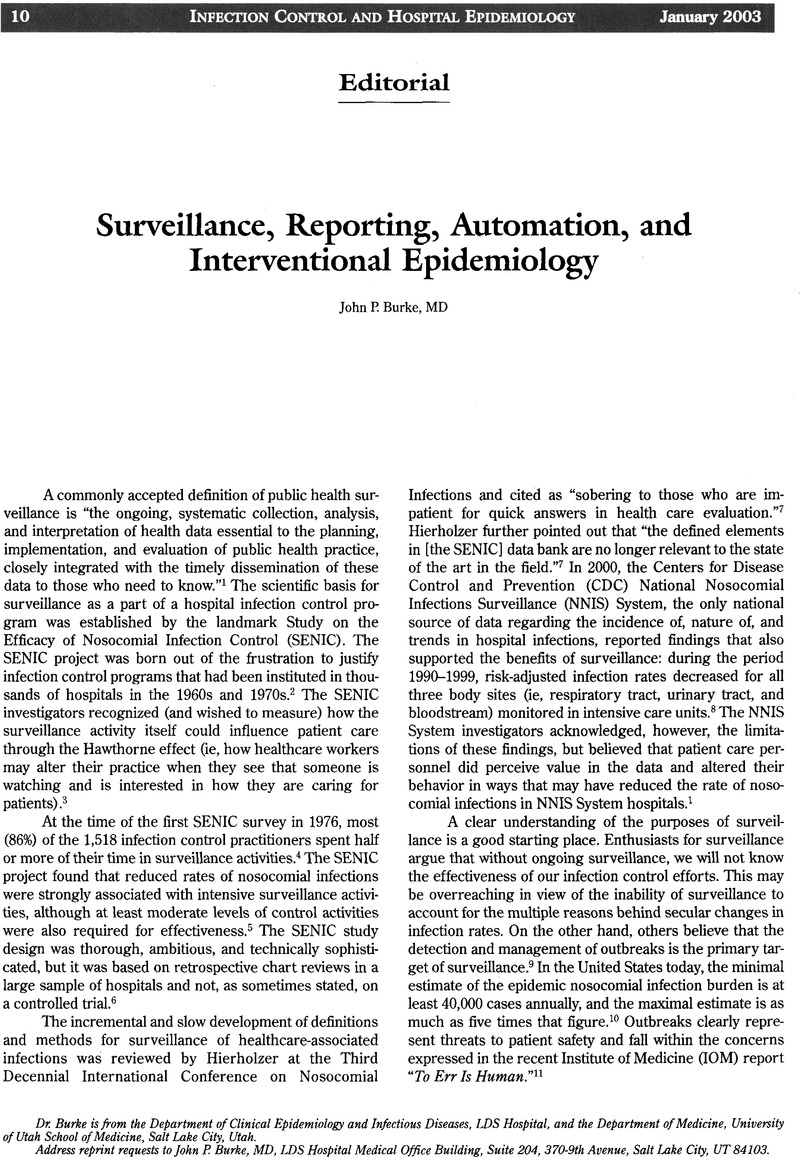Crossref Citations
This article has been cited by the following publications. This list is generated based on data provided by Crossref.
Peterson, Lance R
Hacek, Donna M
Rolland, Diana
and
Brossette, Stephen E
2003.
Detection of a community infection outbreak with virtual surveillance.
The Lancet,
Vol. 362,
Issue. 9395,
p.
1587.
Graham, Philip L
San Gabriel, Pablo
Lutwick, Suzanne
Haas, Janet
and
Saiman, Lisa
2004.
Validation of a multicenter computer-based surveillance system for hospital-acquired bloodstream infections in neonatal intensive care departments.
American Journal of Infection Control,
Vol. 32,
Issue. 4,
p.
232.
Wright, Marc-Oliver
Perencevich, Eli N.
Novak, Christopher
Hebden, Joan N.
Standiford, Harold C.
and
Harris, Anthony D.
2004.
Preliminary Assessment of an Automated Surveillance System for Infection Control.
Infection Control & Hospital Epidemiology,
Vol. 25,
Issue. 4,
p.
325.
Orsi, Giovanni Battista
Raponi, Massimiliano
Franchi, Cristiana
Rocco, Monica
Mancini, Carlo
and
Venditti, Mario
2005.
Surveillance and Infection Control in an Intensive Care Unit.
Infection Control & Hospital Epidemiology,
Vol. 26,
Issue. 3,
p.
321.
Bellini, Cristina
Petignat, Christiane
Francioli, Patrick
Wenger, Aline
Bille, Jacques
Klopotov, Adriana
Vallet, Yannick
Patthey, René
and
Zanetti, Giorgio
2007.
Comparison of Automated Strategies for Surveillance of Nosocomial Bacteremia.
Infection Control & Hospital Epidemiology,
Vol. 28,
Issue. 9,
p.
1030.
Dellit, Timothy H.
Owens, Robert C.
McGowan, John E.
Gerding, Dale N.
Weinstein, Robert A.
Burke, John P.
Huskins, W. Charles
Paterson, David L.
Fishman, Neil O.
Carpenter, Christopher F.
Brennan, P. J.
Billeter, Marianne
and
Hooton, Thomas M.
2007.
Infectious Diseases Society of America and the Society for Healthcare Epidemiology of America Guidelines for Developing an Institutional Program to Enhance Antimicrobial Stewardship.
Clinical Infectious Diseases,
Vol. 44,
Issue. 2,
p.
159.
Steinmann, Jörg
Knaust, Andreas
Moussa, Andre
Joch, Judith
Ahrens, Annette
Walmrath, Hans-Dieter
Eikmann, Thomas Friedrich
and
Herr, Caroline Eva Wella
2008.
Implementation of a novel on-ward computer-assisted surveillance system for device-associated infections in an intensive care unit.
International Journal of Hygiene and Environmental Health,
Vol. 211,
Issue. 1-2,
p.
192.
Wright, Marc-Oliver
2008.
Automated surveillance and infection control: Toward a better tomorrow.
American Journal of Infection Control,
Vol. 36,
Issue. 3,
p.
S1.
Furuno, Jon P.
Schweizer, Marin L.
McGregor, Jessina C.
and
Perencevich, Eli N.
2008.
Economics of infection control surveillance technology: Cost-effective or just cost?.
American Journal of Infection Control,
Vol. 36,
Issue. 3,
p.
S12.
Wright, Marc-Oliver
Fisher, Adrienne
John, Maria
Reynolds, Kate
Peterson, Lance R.
and
Robicsek, Ari
2009.
The electronic medical record as a tool for infection surveillance: Successful automation of device-days.
American Journal of Infection Control,
Vol. 37,
Issue. 5,
p.
364.
Greene, Linda R.
Cain, Theresa A.
Khoury, Raed
Krystofiak, Sharon P.
Patrick, Marcia
and
Streed, Stephen
2009.
APIC position paper: The importance of surveillance technologies in the prevention of health care-associated infections.
American Journal of Infection Control,
Vol. 37,
Issue. 6,
p.
510.
Grota, Patti G.
Stone, Patricia W.
Jordan, Sarah
Pogorzelska, Monika
and
Larson, Elaine
2010.
Electronic surveillance systems in infection prevention: Organizational support, program characteristics, and user satisfaction.
American Journal of Infection Control,
Vol. 38,
Issue. 7,
p.
509.
Torriani, Francesca
and
Taplitz, Randy
2010.
Infectious Diseases.
p.
76.
Halpin, Helen
Shortell, Stephen M.
Milstein, Arnold
and
Vanneman, Megan
2011.
Hospital adoption of automated surveillance technology and the implementation of infection prevention and control programs.
American Journal of Infection Control,
Vol. 39,
Issue. 4,
p.
270.
Galar, Alicia
Kulldorff, Martin
Rudnick, Wallis
O'Brien, Thomas F.
Stelling, John
and
Nishiura, Hiroshi
2013.
Biochemical Phenotypes to Discriminate Microbial Subpopulations and Improve Outbreak Detection.
PLoS ONE,
Vol. 8,
Issue. 12,
p.
e84313.
Larson, Elaine
Behta, Maryam
Cohen, Bevin
Jia, Haomiao
Furuya, E. Yoko
Ross, Barbara
Chaudhry, Rohit
Vawdrey, David K.
and
Ellingson, Katherine
2013.
Impact of Electronic Surveillance on Isolation Practices.
Infection Control & Hospital Epidemiology,
Vol. 34,
Issue. 7,
p.
694.
de Bruin, J. S.
Seeling, W.
and
Schuh, C.
2014.
Data use and effectiveness in electronic surveillance of healthcare associated infections in the 21st century: a systematic review.
Journal of the American Medical Informatics Association,
Vol. 21,
Issue. 5,
p.
942.
De Bus, L.
Diet, G.
Gadeyne, B.
Leroux-Roels, I.
Claeys, G.
Steurbaut, K.
Benoit, D.
De Turck, F.
Decruyenaere, J.
and
Depuydt, P.
2014.
Validity analysis of a unique infection surveillance system in the intensive care unit by analysis of a data warehouse built through a workflow-integrated software application.
Journal of Hospital Infection,
Vol. 87,
Issue. 3,
p.
159.
Ye, Dan
Shan, Jinglan
Huang, Yongbo
Li, Jianchun
Li, Changan
Liu, Xiaoqing
He, Weiqun
Li, Yimin
and
Mao, Pu
2015.
A gloves-associated outbreak of imipenem-resistant Acinetobacter baumannii in an intensive care unit in Guangdong, China.
BMC Infectious Diseases,
Vol. 15,
Issue. 1,
de With, K.
Allerberger, F.
Amann, S.
Apfalter, P.
Brodt, H.-R.
Eckmanns, T.
Fellhauer, M.
Geiss, H. K.
Janata, O.
Krause, R.
Lemmen, S.
Meyer, E.
Mittermayer, H.
Porsche, U.
Presterl, E.
Reuter, S.
Sinha, B.
Strauß, R.
Wechsler-Fördös, A.
Wenisch, C.
and
Kern, W. V.
2016.
Strategies to enhance rational use of antibiotics in hospital: a guideline by the German Society for Infectious Diseases.
Infection,
Vol. 44,
Issue. 3,
p.
395.





